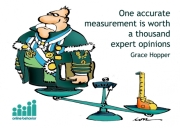The PR budget is based on what is often an unspoken assumption: that getting the word ‘out there’ through web content and the media will help sell whatever it is you have to sell. But does it? Now that I’ve seen it from both the agency and corporate side, here’s what I’ve learned.
The good news is that it really does seem like PR works. More and more, I’m hearing anecdotes about sales that resulted from PR placements and campaigns. This is really cool – that is to say, it’s gratifying that my work and the work of our agency is paying off. But those are just anecdotes, after all. The measurement that really gets me excited is…
You can correlate PR campaigns with web traffic. I’ve had the opportunity lately see something simple that not many PR folks do: correlate web traffic data to press releases. For the most part, PR works – you actually do see a spike in web traffic when you put out a press release. But what you don’t necessarily see is a big spike that you can attribute directly to what we spend the most time seeking: feature placement in a major medi a outlet. What’s the deal with that? Should we not bother? Um, no… because when you think about it, you realize that…
Your goal is more than web traffic. Or maybe it wasn’t web traffic at all. Maybe it was awareness. A VP of Marketing at a startup once told a colleague of mine that his goal for PR was knowing recognition of the new company by whoever sat next to him on the airplane. Perhaps fortunes are made of such awareness. Another tech executive recounted that it was always clear to prospects that their technology was a superior solution – but only after an hour-long PowerPoint. How do you measure when PR raises awareness, or tells a story that accelerates time to sale?
Unfortunately, measurement tends to be expensive and time consuming. You’ve got so much time in the day, only so many people to do the work. You have to make choices: should I do the work, or measure it?
Here’s my Ideal World PR measurement program:
Audience target and reach: I hate PR measurement that simply counts clips — which really only measures your success at generating clips … extent of reach into target market audience is much, much better.
Awareness: aided and unaided awareness of PR-driven messages, pre-and post campaign, or simply 2X per year. Answer is based on direct surveys of selected target market.
Web traffic: If the web traffic increases following an announcement or campaign, it means something in the message caused someone to take action. Action is good.
Inquiries: Correlate number of sales inquiries to PR campaigns, however those inquiries arrive.
Time to sale: OK, so it’d be hard for PR to take credit for this, but what if you could measure average time to sale across the business, then up the ante on your awareness and thought leadership campaigns, and then see if you had an impact on time to sale. Wouldn’t that be cool…as in really, really valuable?
Sales: Maybe you can only measure this by anecdote. Maybe there’s a way code PR related referrals that lead to sales into salesforce automation systems.
Let’s discuss:
We don’t live in an ideal world, of course, so here’s the study question:
What should you measure to get the most bang for the buck – to know the program is working and help you make better decisions for next time?





Recent Comments